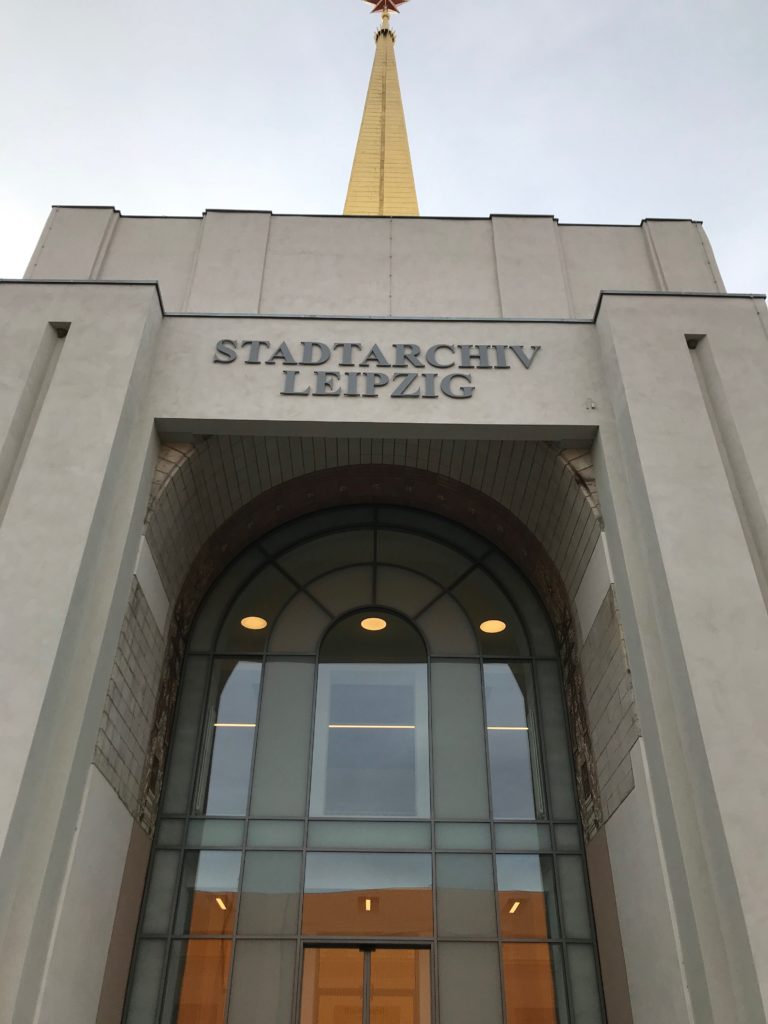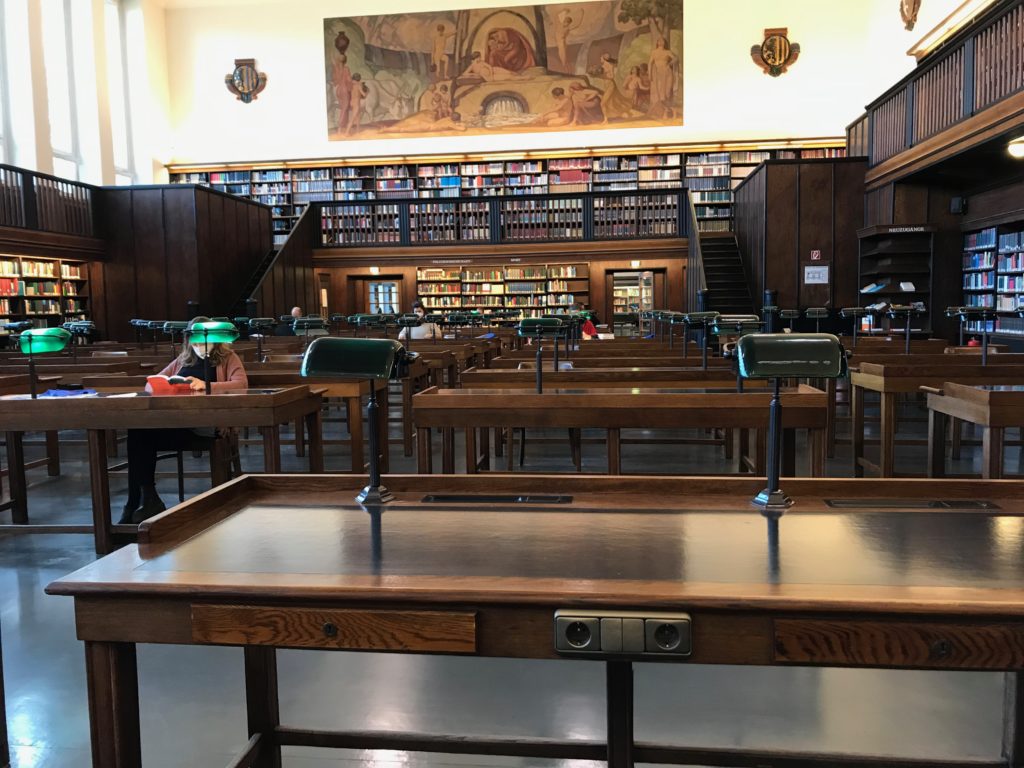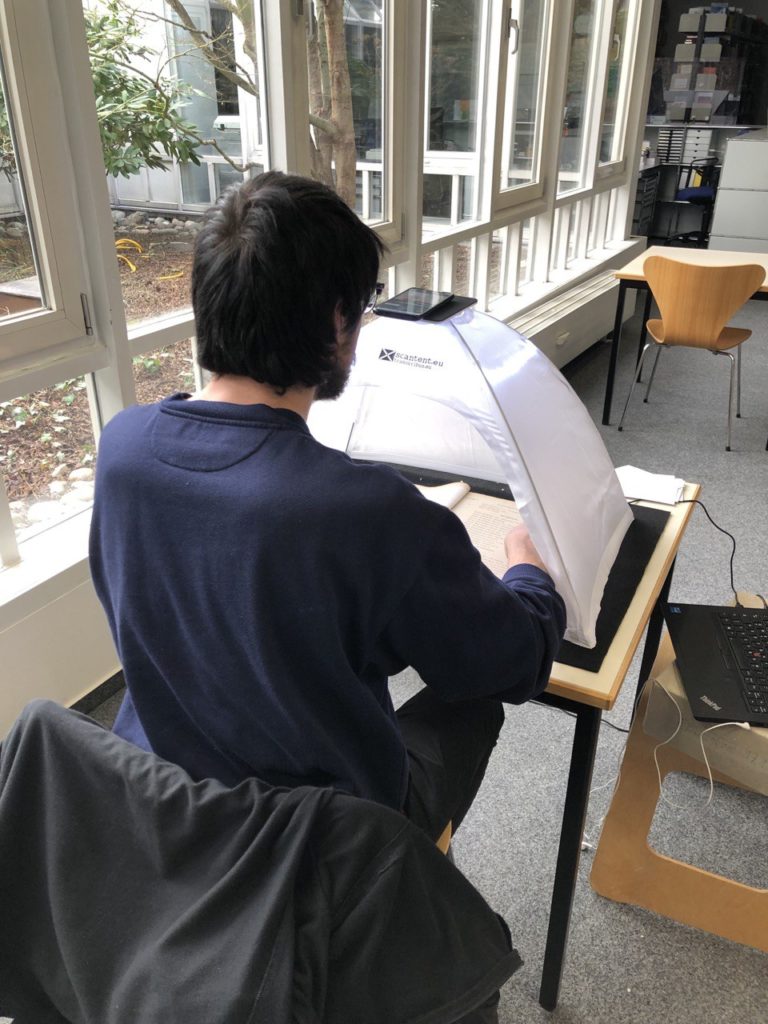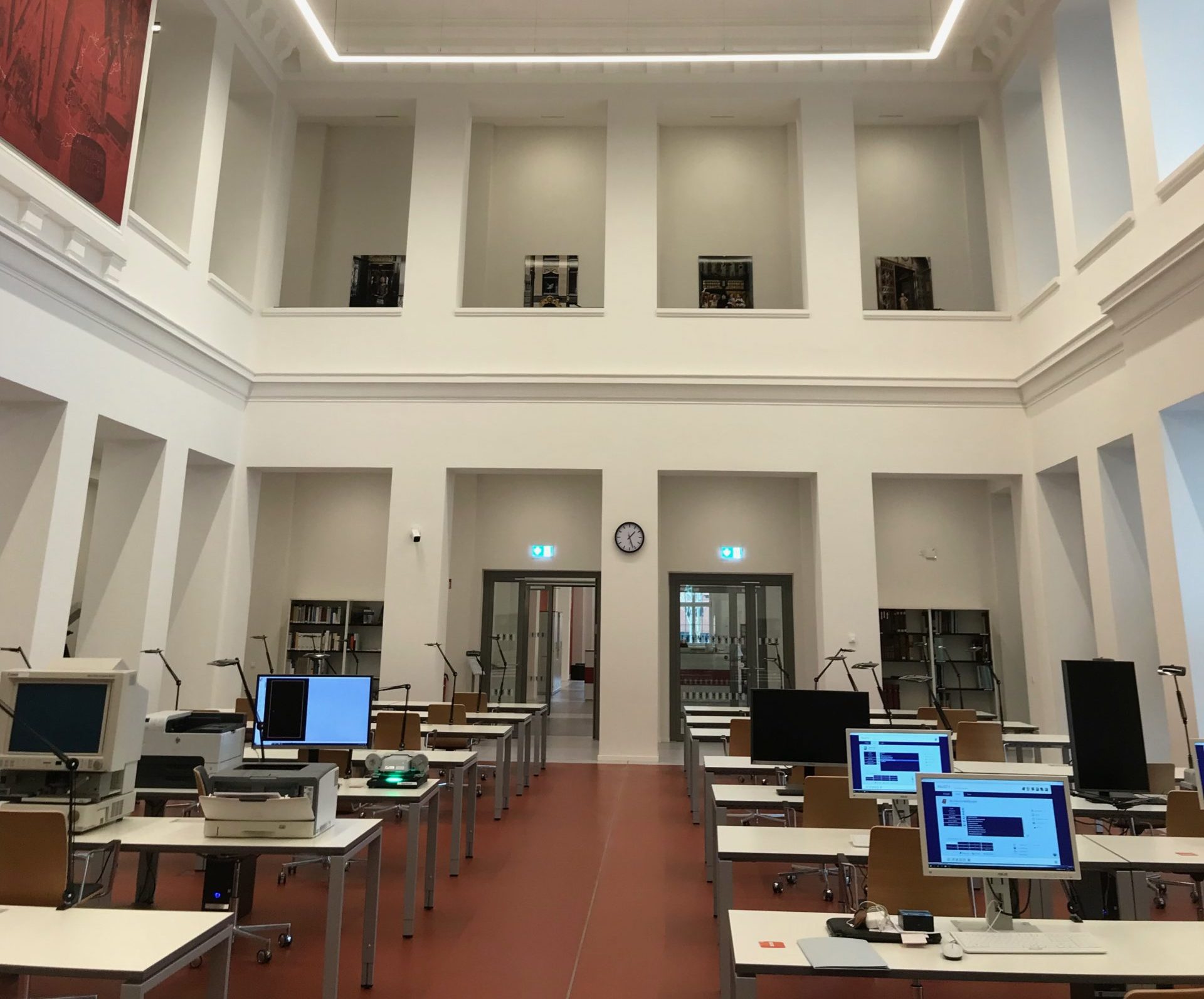Archive work is crucial for historians. Despite advancing digitisation and online access of archive material, going to the archive is still essential today. This applies in particular to the development of a digital edition of sources, which aims to expose legal sources that have not yet been made accessible. For our project “Non-state law of the economy”, we are researching these sources in German state, regional and economic archives. When visiting such archives, a number of rules must be observed. These include presenting the project to the archive management, registering in advance for the archive visit, pre-ordering files – which is often limited to a number of ten, and certain rules of use on site – which can vary greatly depending on the archive. For a project as broad as ours, familiarising oneself with the respective regulations is time-consuming and tedious. The pandemic that followed five months after the start of the project caused rules to become more stringent. With the closure of the archives, the realisation of the project in its planned scope was even in question.

With this contribution, we want to give an insight into the change in the use of archives during the pandemic from the project’s perspective. Thus, we would like to stimulate further discussions about working with archives and the recent challenges. Since our project deals with questions of legal history as well as social and economic history, we want to address the question of which sources we searched for and what we found in the archives. In the third part of our contribution, we will address questions of digitisation. For example, what resources are available to researchers for the individual reproduction of sources and what challenges do projects face that use their sources for digital processing.
A regime under pressure. Archive travel in times of Covid-19
Dear Sir or Madam,
the […] State Archive has decided, due to the current risk of infection with the corona virus, to close the reading rooms of all locations from Monday, 16.03.2020, until further notice […]
It is not yet possible to predict when the reading rooms will reopen for direct use. Please keep up to date on this via our homepage […].
We ask for your understanding.
With kind regards,[1]
With the closure of schools, kindergartens and workplaces, archives also went into emergency mode after the first Covid 19 cases in Germany became known and the federal government decided on a nationwide shutdown in spring 2020. This meant that archivists had to work in their home offices from one day to the next. Since enquiries about archive use and collections could only be answered from the archive for data protection and technical reasons, communication became difficult— especially since the most important question, when the archives would be reopened for use, could not be answered. Most archives were not prepared for a quick switch to digital use of the collections. Although some archives had already proactively promoted digitisation before the pandemic and had transferred digitisation of certain collections to external companies, a digitisation on demand that would spontaneously react to user requests could not be implemented so quickly. The underlying reasons were both financial and practical because the digitisation of entire collections is linked to personnel that was not available in the archives and could not have been hired at the moment of the pandemic. A reflection on the changes in archives during the first wave of Covid was compiled by the Heidelberg City Archives on their homepage in summer 2020. The individually described impressions of archive managers from different regions around the world describe the diversity and inventiveness of the staff to stay in contact with users. However, the most urgent question, how the archive material could be made available to users again quickly, remained unanswered in all cases.
The fact that the closure of the archives would have immediate consequences for historians at every stage of their academic careers but would especially affect those whose research projects were limited in time, was recognised relatively early. As late as the end of 2020, the Association of Historians (Verband der Historikerinnen und Historiker, VHD) wrote: “The closure of or severely restricted access to the reading rooms of the archives makes planning almost impossible. When archives are open, there is extensive waiting time for a workplace, delaying the research process and the completion of the research project.” The VHD therefore called on the German Research Foundation as well as research and funding institutions to support historians with fixed-term contracts with six months of final funding. This appeal was implemented by many institutions but could not solve the problem of accessibility to archival material either.
As the pandemic situation became less severe, the archives gradually reopened. However, the regulations differed greatly, which is mainly due to the diversity of their ownership. Archives that we rely on for our project are in private hands, municipally or state-run and introduced very different protective measures in dealing with Covid-19. What they all had in common, however, was that it was difficult to get a slot for archival work. Capacity was reduced to ensure distance and reduce the risk of infection to a smaller group of people. This required registration and fixed appointments in advance, which served both to regulate the number of visitors and to register contacts for tracing chains of infection. This enabled the archives to ensure a certain level of operation, although the low capacity led to long waiting lists. As travel and mobility continued to be limited in the second year of the pandemic, the project team was discussing which travel was necessary and which could be postponed. As a result of the uncertainty about how the pandemic situation would develop, it was important that we collected material on a large scale during pandemic relaxation in order to anticipate renewed archive closures.
Search and find. Legal sources in economic and state archives
Dear Mr […],
As an attachment to this e-mail, you will receive an overview of search results, I have been able to locate in response to your enquiry.
To be honest, I expected more results, but especially the social aspects are much more documented in the textile industry and less in the metal industry. There are probably a few more sources that are not recorded in the EDP system, but I do not think there will be more than that.
You are welcome to consult these documents in our Archive. However, in the week you mentioned, 11-15.102021, I can only offer you Wednesday to Friday (13.-15.10.2021), as due to the general circumstances, only one person is currently allowed to work in our reading room and Monday / Tuesday (11./12.10.2021) are already occupied.
Please let me know if, and if so, on which day you will be visiting us and which of the documents you would like to see.
Since a part of our collection is stored in our external stacks, I would be grateful for your timely reply.
Kind regards,
Before the actual work of reviewing files in the archive begins, the first question is how to locate relevant source material. Our project is interested in normative sources that regulated everyday work and industrial relations in the metal industry of the 19th and 20th centuries. We are searching for internal company regulations such as work and factory rules or regulations with a socio-political reference, such as statutes of company health insurance and pension funds. Archivists can provide initial assistance with the search for this specific material as we were assisted in selecting file signatures. In most cases, however, extensive support exceeds the capacities of the archives. Therefore, one’s own look into the existing material cannot be omitted. This can be done on the basis of the paper finding aids. In our case, these were repertories of the collections of individual companies, files of chambers of industry and commerce, industrial associations, district governorships (Amtshauptmannschaften), trade or police offices. Despite the fact that archives are increasingly offering online services, it is often only possible to consult paper finding aids on site. Even though most of the collections can be searched for on the computer with the help of archive software, the databases can only be used locally and therefore a visit to the archive is necessary. During the peak of the pandemic, this was not possible – as already mentioned.

It is therefore all the more helpful that most German state and economic archives – and in some cases also larger city archives – allow online search for their sources. The digital finding aids can be searched in two different ways: by full text search and by searching the tectonic tree of the collections. For the former, we agreed on common search terms in the project group to ensure a uniform and systematic review of the respective archive collections. However, the disadvantage of this procedure is that material not listed under these terms cannot be found in this way. It is therefore advisable to also use the tectonic tree as a search tool. Similar to the procedure with analogue paper finding aids, the collections of companies or associations can be viewed in a hierarchised scheme. However, in order to actually record all relevant sources, manual review of the files and thus a visit to the archive is essential.
A good picture. Reproductions in the age of digitalisation
Dear Mr. […],
Thank you very much for your request.
Unfortunately, your order of reproduction exceeds the usual volume to a large extent.
Given the minimal staffing of our archive, I see no other option than to carry out this reproduction work together with student assistants. However, according to our schedule of fees […] an additional 50 euros per hour is charged for this. It is difficult to estimate how high the time expenditure will be with 130 single archival documents from Abt. […], (without indication of page numbers) and with 24 files with a total volume of approx. 260 pages from seven collections, but I am quite sure that 20 hours will not be sufficient. My rough estimate is that the sum could be at least five times as high as the upper limit you communicated. Especially since the scans alone probably cost a total of 1,000 euros. The binding of the files must be partially loosened or opened, the papers must be partially removed, depending on the binding, and the archival records must then be treated for conservation. The scanning process and also the administration of the scans take some more time. If you wish to accept this offer, I kindly ask you to confirm this to me. Calculated bills will be issued according to expenditure.
With kind regards,
The creation of a digital source edition goes hand in hand with the reproduction and evaluation of a large amount of source material. The abundance of material to be digitised poses new challenges for the organisation of work steps and capacities, regardless of Corona. Also, the way many historians work have changed due to the resources and individual scholarly use. In order to keep archive travel and thus financial expenses low, the duration of an archive visit has shortened enormously. Relevant materials must be efficiently selected and digitised as the actual work with the sources usually no longer takes place in the archives.
This also raises the question of how sources can be reproduced efficiently and with the necessary quality. In the case of digitisation projects, the images must meet certain requirements to be used for further processing with automatic text capture (Optical Character Recognition, OCR,). In order to produce better image quality when taking photographs, we decided to use a ScanTent in the project. This ensures even light sources, a constant distance between the camera and the sources, and a stable support for the smartphone. Docscan is a suitable, free software for the smartphone. The main benefit is the direct conversion into OCR-readable documents as well as the structuring of the created photos, which can quickly become confusing when working with many data sets.

The reproduction of a large number of sources requires a workload that should not be underestimated. Outsourcing reproduction work to the archive would bring enormous advantages, which are, however, correlated with financial costs. And these costs are often not considered in project planning. The archives provide high-resolution scans that can be further used for OCR text recognition. If the normative texts to be reproduced can be identified via existing online indexes, digitisation would even be possible without an archive visit. However, as can be seen from the e-mail, reproduction orders to archives mean higher costs. Due to the lack of staff, external companies have to be contracted or new personnel must be hired, which in our case would have far exceeded the capacity limits of the project.
We encountered very different digitisation policies in the archives. The reasons for this lie, on the one hand, in the diversity of the archives themselves. Private archives are often not interested in digitisation because they want to retain sovereignty over their collections and their use. There is also the fear that archives could lose their reason for existence. Other archives, on the other hand, were very open to reproductions in an academic context. In between were various gradations of what was permitted: taking photos of sources up to a certain year of origin, control of what was photographed, or a quantitative limit.
However, it is not up to the archives alone whether digitisation projects can be implemented. A lack of financial resources also slows down those archives that are open to digitisation. They are often unable to undertake large-scale digitisation projects themselves. They are dependent on interests of others approaching the archives and bringing project funds. In other countries, though, they think on a larger scale. In Switzerland, for example, the Federal Archives received the state mandate to become a “digital archive” as early as 2008. Digital copies can now be ordered there on demand. What has not yet been digitised is digitised free of charge upon request. In this way, the digital material grows with every order.
[1] We received these emails from different archives during the pandemic. We have anonymised them to give them an exemplary character. Translations are by the authors.
Cite as: Working Time Project Group: Challenges of a digital source edition project during a pandemic, legalhistoryinsights.com, 21.07.2022, https://doi.org/10.17176/20220721-153218-0



 This work is licensed under a
This work is licensed under a 